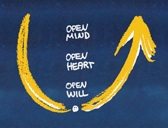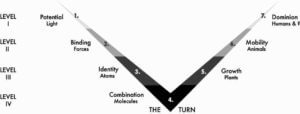Thinking About Frames: Is Process a Swoop or an Arc?
Upon reading a George Lakoff critique of the “framing” in eco America’s new report on global warming (see recent post) I experienced a flash of insight in regard to a puzzle that’s been nagging at me since hearing Otto Scharmer talking about Theory U at a recent Thought Leader Gathering in San Francisco (see my post on Theory U).  The graphic visualization of Theory U is what I would call a “swoop”, a compelling little visual shown here. Why did Arthur M. Young, my teacher about Process Theory, insist process should be visualized as a “turn” or “V?” as illustrated below? In our study group with Arthur we would often argue with folks who wanted to visualize it as a smooth arc rather than 90o.
The graphic visualization of Theory U is what I would call a “swoop”, a compelling little visual shown here. Why did Arthur M. Young, my teacher about Process Theory, insist process should be visualized as a “turn” or “V?” as illustrated below? In our study group with Arthur we would often argue with folks who wanted to visualize it as a smooth arc rather than 90o. 
This may seem like an abstract puzzle, but Lakoff’s article suggests otherwise. He states without qualification that cognitive scientists agree that “frame circuits” in the cortex and nervous system guide our sense perceptions, and that these are held in place by values. The frames that keep getting reinforced in our experience become hard wired. They become the window through which we look through when we see—the directional microphone through which we hear—the guide to what we touch and sense.
(Of course “frame” itself is a frame, or what many would call a metaphor). A common sense interpretation is that we assess the value of a painting or picture as much by its setting, its “frame,” as by the work itself.
I’m fairly sure that Lakoff would agree that the “swoop” in Theory U is a “frame” as is the “V” in Process Theory. So what difference does this make?
Theory U
Both graphics are icons pointing at a fairly comprehensive system of explanations about how things work in the world of process. Theory U is informed by the dialogue and scenario work of Joe Jaworski, Adam Kahane, Peter Senge, and Otto Scharmer, augmented and amplified by the swirl of thinking concentrated in Cambridge and generating new stories of possibility for our time.
Process Theory
Process Theory emerged from Arthur M. Young’s interest in updating the scientific paradigm, and reuniting physics and metaphysics in one system of explanation, a “yoga of thinking” he sometimes called it. His ideas were deeply informed by the process of invention and design, as directly experienced in his invention of the Bell Helicopter, the world’s first commercially licensed vehicle of that kind, and by the practical experimentation of science and the emerging new sciences of quantum physics and relativity.
Graphic Facilitation & Information Design
My own thinking about frames is informed by 35 years of working as a graphic facilitator and information designer, translating spoken language into text/graphic representations all around the world for every imaginable kind of organization. I have also over this time sustained a focused inquiry into all the different kinds of systems of graphic representation that claim to be integrative and holistic.
There is some kind of comfort and deep familiarity in the “U” graphic of Theory U. It’s drawn by hand and arcs down to a little dot, then smoothly back up to an arrow. It suggests the bottom of a bowl, or crucible, the bottom of a roller coaster ride, or the swoop of a bird. It suggests that process is an even flow through, with a little “pip” when source enters into the picture.
Arthur’s used geometry and angular relationships as a formal language to make his points about process. In his “frame” the ineffable, the source, our potential is without bounds or form, and takes on constraint as it manifests, first through the action sparked by intention, then by our representations in communications, and finally in the physical world. He represented these distinctions on a carefully constructed axis, where “x” was time and “y” was four levels of constraint, from 3 on the physical plane to 0 on the plane of pure consciousness.
I’ve come to see that the gist of this freedom-constraint frame is actually already hard wired into our perceptions due to the fact that humans are vertical most of the day. “Concrete reality” is generally experienced as down towards the ground, and wide open space and unconstraint is experienced as up toward the “blue sky.” So graphically showing this process as a descent maps into our already established somatic (physical) frame of reference. There are common sayings like “he has his head in the clouds,” or “she has her feet on the ground” that point to this frame.
Both Arthur and Otto point to what happens when we the universe as a whole system, and connect our consciousness and intention with our physically manifest lives. Arthur shows it as a 90o angle. Otto shows it as a dot in the swoop.
For most of us, this integration isn’t on top of mind. The origins of all that we experience physically aren’t necessarily clear. We see the results, but the thinking, feeling, and intention that set this all in motion may not be clear. Many people don’t see a direct connection between their work and the original purposes that propelled founders to create a business or organization. We often have no idea where our food comes from, let along what the farmer was intending when planting the crop. We don’t always know the original intent behind our laws. Much of life is lived automatically if the truth be told – especially when we are rushing to go faster and faster.
Otto describes this unconsciousness persuasively as the way in which people in group processes “download” what they already know most of the time, rather than really listening. This point is supported by the “U” frame, and get’s us started down the sliding line into the bowl. Then we listen for facts, and then listen empathetically, and finally we “dig deep” and connect with source. This is represented by the dot.
Listening through the frame of Process Theory I of course heard the progression from hard wired downloads, to factual inquiry, to empathy, to source is a progress from constraint to freedom, only in this mapping upside down from the way Arthur visualized the same progression.
As Otto got into his talk, he described connection with source as going “deep.” Here is another metaphor, and one that is often associated with
down.” That is the case with Theory U. It suggests moving into our “point” of view, the source of our inspiration and motivation, and coming from that place. When that happens process turns back up toward the arrow.
Arthur Young observed that we live in our grounded reality most of the time, and overlay it with thinking, and feeling—represented as levels of increasing freedom, one on top of the other. Above all, and in fact permeating and containing all, is consciousness—the unbounded source of our perception. It is represented as the top level. This maps into the “feet on the ground head in the sky” hardwired orientation of most people.
This takes us to the question of representing the joining of these things as a sharp turn or a smooth swoop.
Arthur’s experience suggested that a “Turn” in process happens when we bring that consciousness directly to bear on our physical realities and come to a new insight about how things not only do work, but also could work. In his experience as an inventor, this moment isn’t a smooth arc, but a real “turn” in consciousness toward a new direction of activity. We literally turn, not slide through continuing on our path but now starting to move up.
Using this “V” frame as a facilitator, I have come to look for that moment in groups, and experience it happening in an instance. It happens when loved one’s die. One moment the world is ordered one way, and the next minute we are in a new direction. It is the epiphany addicts can experience when they “bottom out.” It is the moment in Team Performance we at The Grove describe as the point where the force of intention impacts the bottom line constraints of budget, staffing, and schedules. When a group comes to a singularity out hall this kits together with their driving purpose, the result is like the bounce of a ball.
I feel like our whole world hit such a “Turn” this last October, and from the perspective of history, this “moment” of time, which may be a several months or years, will be seen as a turning point and a heading in a truly new direction. It isn’t a smooth curve.
Yet I love the comfort and appeal of the “U,” the idea of going deep inside to source, and the call to join our inner selves and outer actors in forward action.
Yet I love the sharp distinction of what Arthur called the “Arc,” and looking for the turns in group and individual process. And I like underlining the huge difference of being on one side of the process versus the other.
Most of all I love the fact that these two “frames” both orient toward the same underlying truth, that universal process is a joining of spirit, soul, mind and matter in a concert of forward action.


Ria Baeck
June 13, 2009Thanks a lot for pointing out these differences!
Ria